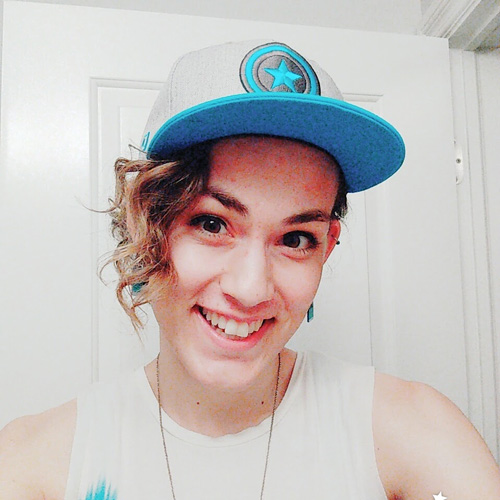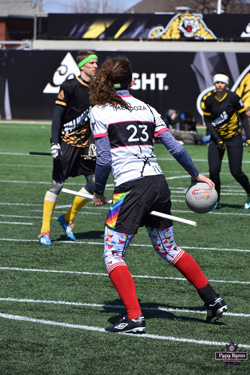
Cayley Mendoza is a 25-year-old living in Edmonton, who has played and coached competitive sports for most of her life. Like many athletes, her sports of choice expose her, and other players, to the risk of concussion. She shared her own experiences with concussions and recovery with us:
Tell us a little about yourself, Cayley.
Hi! I’m a fourth-year English student at the University of Alberta. Sports have been a huge passion of mine for a lot of my life, and I do a lot of playing and coaching. Every season I have a couple of sports on the go.
What sports do you play?
Quidditch is my main competitive sport now – I play for a few teams, including Canada’s National Team. For those unfamiliar, quidditch is like a combination of handball, dodgeball, and rugby. I also play ultimate frisbee, cycle, ski, and row recreationally. I also coach ski racing and quidditch.
Do these have a higher risk for concussions compared to other sports? What kinds of things make them more/less risky?
The concussion risk is dependent on a number of things. I’d like to point out that no sport or activity is totally concussion-free. It’s less about how hard a hit is than how your head is hit. Reducing risk is the name of the game. A full-contact sport (like quidditch) is more risky. Sports and activities with more contact, falling risk, or other chances of head impact will be a bit more dangerous in terms of concussions. Of course, there are many ways to make them as safe as possible, but the risk is a lot higher than, say, non-contact sports.
You’ve had some history with concussions – what happened when you were injured?
I’ve had a few minor concussions from playing sports, both as a teenager and an adult. Some were the result of gameplay that could have been a lot safer (lessons were learned the hard way, I guess) while others were just accidents.
My worst concussion actually came from an everyday skiing accident. I was 18 at the time and simply lost my balance while training. The safety netting did its job to save me from crashing into the trees, but I ended up with a serious concussion.
What kinds of symptoms did you have?
Every concussion is different. Concussions are complicated injuries to a very complicated part of your body – your brain.
My first concussion was very lucky and relatively minor. I only had light symptoms for a few days.
My worst concussion was entirely different. I lost a lot of control over a number of skills and reflexes: I had to reteach my fingers how to type, write, use cutlery, etc.; I lost a lot of coordination; I developed a tremor in one of my arms; I developed a pretty severe stutter; and my ability to read and process information suffered. My eye tracking reflexes suffered, too, making me nauseous with simple things, like travelling in vehicles. My brain was really easily overwhelmed by normal situations. Something like a radio playing in the background while someone tried to talk to me could be too much to process.
All of these made it a frustrating recovery process – it was a long recovery process that yo-yoed over 2 years. I did get back to normal eventually, with a lot of rest and working with my neurologist and physiotherapist. Cases like mine are rare, but not unheard of.
I’ve had other concussions from sports since that one, too. These also had different symptoms, but didn’t involve such difficult recoveries.
What was the road to recovery like?
Recovery has been different for each concussion. They have varied from a couple of days to a couple years to get better.
While I was recovering I was very careful to avoid any risks for another concussion – an impact on a concussed brain can cause Second-Impact Syndrome, which is very dangerous and risks permanent damage or even death. Recovery followed a process that started with rest and gradually reintegrated work, school, and activity. I had the help of a neurologist and physiotherapist to help me along the way, too.
Between your own experiences and the experiences of those you play/compete with, you’ve seen a few concussions. What are the top myths you hear that you want to dispel?
Myth 1: “My head no longer hurts, so I’m good to get back into the game.” You can still be concussed even if you feel okay at rest. Also, while many concussions resolve in a month, others can take longer to heal.
Myth 2: “My helmet and mouthguard prevent me from getting concussions.” There is no such thing as equipment that can prevent concussions. Protective gear like helmets, padded headbands, and mouthguards help to reduce impacts, but aren’t able to protect you entirely. Playing smart is an important part of reducing risk, too.
Myth 3: “It takes one mega-hit to get a concussion.” A number of smaller impacts to the head can add up into something more serious. You certainly don’t need to be knocked unconscious to be concussed – if you’re feeling concussion symptoms, take it easy and play it safe.
Myth 4: “It’s just a concussion. It’s not that bad.” A concussion is a serious brain injury, and it should be treated that way. There are big risks with playing while concussed. This isn’t an injury you want to “push through”.

Do you think that it’s still worth it to play, even with the risks involved?
For me, it totally is still worth it to play. I weigh the positive impact that my sports have on my daily life against the negatives. The joy, fitness, community, focus, and fun that I get from sports every day makes them worthwhile. I always try to play smart when I’m playing sports to reduce the risks I take each day. This is a very individual decision for everyone to make for themselves, though – to weigh the benefits against the potential risks.
Before the summer sports season starts – anything important you want to pass on to concerned parents or even young athletes to stay safe?
There’s two big takeaways I want your readers to have. First of all, respect that concussions are serious brain injuries. If you get a concussion, listen to your symptoms and don’t push too hard too fast. You only have one brain – taking care of it and staying safe are important.
Second, I want to reiterate that playing smart is one of the best ways to avoid concussions. Protective gear will not prevent concussions, so the best defence is your actions. Playing smart will help you stay injury-free and will keep you enjoying sports the most that you can every summer!